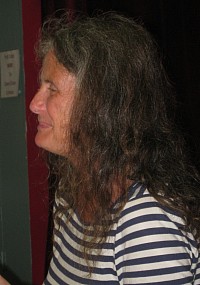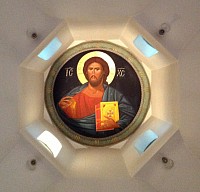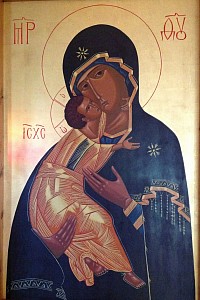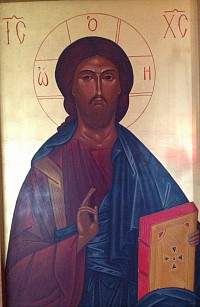Orthodox worship
Our church is growing
Eastern Orthodoxy is bucking the trend in people wanting to explore a spiritual dimension in life. Many churches are seeing a fall in congregation numbers, but evidence is here that we are growing.
While we don't actively proselytise, perhaps one of the reasons we are attractive, we make newcomers welcome. Through our contact page we regularly get enquiries from people wishing to know more. On Saturday 27th April 2024 our congregation was added to by seven new people. Those who hadn't been baptised were baptised and chrysmated, and one who had been baptised earlier in life was chrysmated (you don't need to be baptised twice). Chrysmation is an anointing with oil that has been blessed by a bishop, in our case, the blessing was from the ecumenical patriarch himself.
An Orthodox church is very different from the churches of other denominations. The most obvious physical difference is in the number of ikons there are around. Ikons are an important component of Orthodox spirituality, and rather than take up lots of space explaining things on this page, if you click HERE you will be taken to a gallery of all the ikons that are in our church, a chance to read more about ikons from those who use them, and an explanation of the various stages of their manufacture.
If you come to the Holy Liturgy, not having been to an Orthodox service before, you will notice some unfamiliar things. One of them that should be explained is the practice of Orthodox people writing the names of the living and the departed, for whom they pray, on pieces of paper, and placing small 'rolls' of bread on these lists, which are then carried up to the altar. These small loaves are called 'Prosphora' and, during the preparation service before the main part of the Liturgy, the Priest will read out the names listed and then carve out a small portion from each Prosphora and add this portion to the bread to be consecrated.
These Prosphora are returned to the back of the church at the end of the Liturgy for people to consume after the service has ended.
The next thing a visitor might notice is that worshippers, on entering the church, will approach an ikon on a stand in the centre of the church, crossing themselves and touching the floor (sometimes several times). They will then do the same to the ikon that depicts Christ, the Crucifixion ikon, the ikon of Mary and the infant Jesus, and sometimes some of the ikons of the saints. What is happening here is very simple. When people meet other people whom they know in the street , there is a greeting. This may be the shaking of a hand, a hug, a kiss or just a smile. In Orthodoxy, ikons are believed to make present to us those depicted in them. Just as we greet one another when we meet, so when we enter the church, we greet Christ, His mother, and the other saints. We do it, of course, with a great sense of awe and unworthiness, and the touching of the ground symbolizes this. Those depicted are not merely greeted, but also venerated.
When venerating the main ikons as they enter the church, worshippers also light candles and put them in a stand near to those ikons. In the lighting of these candles people usually pray silently, often expressing the particular concerns that they bring with them to church.
Orthodox Christians make the sign of the cross not only when venerating the main ikons on entering the church, but also frequently during worship. We do this in the sequence: head to waist and right to left. (Other Christians now usually sign left to right, but this seems to have been an innovation of the 14th or 15th century, and as in so many things the Orthodox way of doing things is the original way). The meaning of making the sign of the cross varies. Sometimes it is a gesture to openly receive a blessing, sometimes it is to visibly recognise one is at a particularly special moment of the service, sometimes it is to acknowledge something deeply personal. There are no hard and fast rules about when and where one is to cross oneself, though there are certain points of the service at which it is customary. Crossing oneself is a personal expression of something deeper than words can express, that can only be expressed physically. It is part of the way in which we use our bodies in worship, not just our conscious minds.
Visitors will also notice that Orthodox worship involves the use of incense at various points. The priest (or deacon if there is one present) frequently salutes both the ikons with incense, and also the worshippers, who - being made in the image of God - are also proper recipients of this salutation. The smoke rising from the censer symbolizes our prayer rising to God, and the sweet smell symbolizes the sweetness of heaven, which in worship we experience in so many ways. The Bible refers to the sacrifices that were burned as "a sweet savour (or smell) unto the Lord". Because we believe that in Christ "the Word was made flesh", the body and the senses also have their role in worship. We are not spiritual beings imprisoned in a body, but a unity of body, mind and spirit, each component having its proper part to play in our response to God.
Apart from the elderly and frail, Orthodox Christians stand for the duration of the main part of the Liturgy. (Absolute uniformity of posture will not be found, however, and you will find that in some parts of the service some sit while others remain standing - we are, after all, children in our Father's house, not troops on the parade ground). The fact that standing is the norm is not, it should be noted, because kneeling is regarded as an improper attitude for prayer. Rather, it is because the main Liturgy of the week - on Sunday when we particularly celebrate Christ's resurrection - is one of such joy that kneeling (a sign of contrition) is considered inappropriate. This Sunday practice has set the pattern for other services, and only occasionally (as in part of the first Vespers of the Pentecost season) is kneeling actually required.
At times people will stoop down and touch the ground. This is a sign of repentance and also a sign that the one who stoops is in the presence of someone or something more senior or having great status.
Every Orthodox church shares a basic common design, although there are variations between small parish churches like our own and larger ones, and also slight variations in different parts of the Orthodox world.
The ikon screen (ikonostasis) separates the people from the altar area. In Orthodoxy, what other traditions in Christianity call the altar we call the Holy Table, and the space beyond the ikon screen is called the altar. Among items upon an Orthodox Holy Table will be a cloth ikon of Christ containing a relic, the gospels, a special 'box' we call a tabernacle which will contain the reserved sacrament for the sick, and candles. In the Russian tradition the number of candles we use reflect the Jewish Menorah, a seven branched candlestick as expressed in Exodus. The Holy Table serves as a memorial for several memories in Christianity. It serves as a reminder of Golgotha, the place where Jesus was crucified. It serves to remind us of the Throne of God, and it serves as a reminder of the the tomb in which Jesus was placed after His death.
Elsewhere in the altar, often out of sight, will be another smaller table designated the Table of Preparation. This is where the bread and wine are prepared, as are the prosphera from the people.
In addition to the ikons around on the walls, in the centre of our church you will find an ikon on a stand. This ikon is chosen to reflect the dedication of the church, or to illustrate the particular period of the church year that is relevant on that particular day.
The arrangement of certain of the ikons is common to all Orthodox churches. The central doors of the ikon screen are known as the Royal Doors, and to the left will always be an ikon of Mary and the child Jesus, while to the right will be an ikon of Christ. If space allows, above the people and usually in the dome of the church, there is often an ikon of Christ "Pantokrator" (the Ruler of All). In our case this has been done by having a false dome in which the ikon is placed.
In the main part of the church is the choir stand. (Note that in Orthodoxy the choir is not set apart, but is placed among the people).
When Christianity began there was no liturgical tradition specific to Christianity, though as St. Paul bears witness, the eucharist was celebrated. Early Christians naturally drew upon Jewish tradition and worship as their practices developed, and Orthodox worship today is in continuity with this worship. It is not surprising, therefore, that within the Orthodox liturgical tradition there are resonances of the Jewish forms. The psalms continue to be of great importance and, in the Holy Liturgy, the bread and wine are brought from the altar and shown to the people, as are the gospels, echoing the procession of the Torah around the synagogue.
The picture shows the choir mistress at our church leading our (small) choir, with much of the music being settings of the Psalms or of texts which are a paraphrase of scriptural texts.
In our church, as in most Orthodox churches, there is no congregational singing (except perhaps joining the choir in singing very familiar parts like the Creed and the Lord's Prayer). However, most of the service is still sung, either by the Priest or the choir. This gives to the services a wonderful contemplative quality, and the fact that the majority of worshippers have no words to say or sing by no means implies that they are not full participants in what is going on. On the contrary, Orthodox worship, if entered into properly, is experienced at the deepest contemplative level, and many who have converted to Orthodoxy have declared that it is the experience of authentic worship in an Orthodox church that has been central to their decision.
Above the body of the church, set into the ceiling, is the Ikon of Christ "Pantokrator" (ruler of all).
To the left of the ikon screen in all Orthodox churches will be an Ikon of the Mary with the Infant Jesus. She is known in Orthodoxy as Theotokos, which means 'birth-giver of God'.
In Orthodox Christianity, the Theotokos holds a special place in the history and life of the church. A hymn often sung in our worship addresses her as follows:
"More honourable than the cherubim
and incomparably more glorious than the seraphim,
thou who in virginity didst bear God the Word,
thee, true mother of God, we magnify."
It has sometimes been suggested that there are similarities in Christian ikonography (and Mary's place in the church) with the Egyptian Goddess Isis and her son Horus. Both are often depicted with the child on the lap of their mother, and the feasts of both Horus and Jesus fall around the latter part of December. Both Mary and Isis are viewed as being the ideal perfect mother, and have been considered to have miraculous powers. While these similarities may be suggestive, however, they do not mean that the two depictions are simply variations on a theme. Many of the Fathers of the church were able to discern, in pagan religion and philosophy, a kind of dim echo of what God intended in his action in and through Christ. For Orthodoxy, what has occurred in history is a fulfilment of what was anticipated in at least some of the mythology of the pre-Christian era. As the Western theologian C.S.Lewis once put in, we need not deny that in pagan myths certain truths are made present to us. However, he went on, the real difference between mythology and the Christian revelation is a stark one: in Christ "the myth has become fact."
The term Theotokos was adopted as a title for the virgin Mary at the Third Ecumenical Council (AD 431), though it had already been in use in the life of the Church for some time. It was a theological statement, emphasising that Mary's son, Jesus, is fully God as well as fully Man, and that His two natures are united as one Person of the Holy Trinity. "Mother of God", which the Orthodox church has adopted, is one of the phrases commonly used to render Theotokos, though it is not an accurate translation. It also has the disadvantage of being a translation of Mater Theou, which is less commonly used, but which occurs alongside Theotokos,, even within the same hymn, potentially leading, in translation, either to tautology or to convoluted renderings of one or other of the phrases.
Other possible translations of Theotokos are "God–Bearer", "Bearer of God", "Birthgiver of God", or "Birthgiver to God". The last though clumsy, is probably the closest to an accurate translation of the meaning. The search continues for a more helpful, accurate and satisfactory translation.
In Orthodox churches the congregation is separated from the altar by the ikon screen known as the ikonostasis. The ikon of Christ always sits to the right of the central (so-called 'Royal') doors.
This ikon is far more dominant in an Orthodox church than any ikon of Christ crucified, since we Orthodox never think of the crucifixion apart from what it leads to: the resurrection. We think of Christ on the cross less as a victim than as a victor, and see the whole of what He has done - his incarnation, birth, ministry, death and resurrection - as a seamless whole. The greatest liturgical expression of our whole year is our Pascha (Easter) service, at which we sing, over and over again,
"Christ is risen from the dead,
trampling down death by death,
and on those in the tombs bestowing life."
Orthodoxy believes that we are called to worship God with all our senses. Music is therefore incredibly important to us. No recording of our own choir singing exists, but most people know that Orthodox music is very different from Western liturgical music and the link left will demonstrate what could be found elsewhere. (Our own small choir cannot, of course, produce music of the aesthetic quality that is found in large churches such as that shown in the link, but even with a choir of limited ability there is still a sense of our worship on earth being a foretaste of the worship of heaven).





